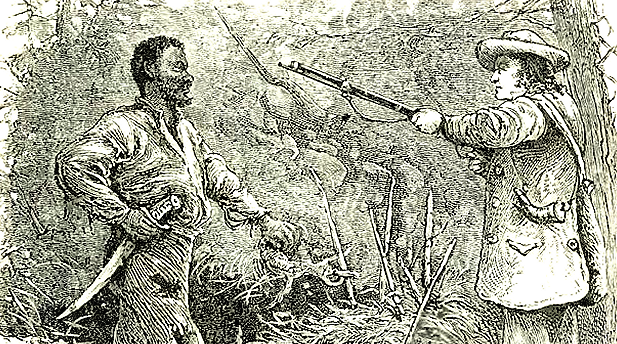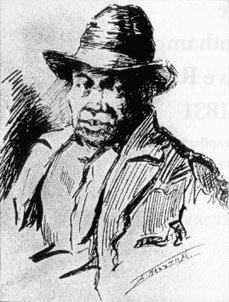Nat Turner (Slave Revolt) Trials
The Nat Turner “Slave Revolt” Trials: An Account
by Douglas O. Linder (2020)

The capture of Nat Turner
The most famous slave revolt in American history took place in a backwater Virginia county in August 1831. The revolt, led by a 30-year-old slave named Nat Turner, would lead to the deaths of over 200 slaves and free blacks, and about sixty whites. In the trials that followed the revolt, twenty-one participants, including Turner, would be sentenced to be hanged.
The Turner-led revolt profoundly affected the course of American politics. Many southern whites came to see the revolt as part of a larger Northern abolitionist plot. Their charges brought national attention to outspoken abolitionists such as William Lloyd Garrison. For the first time, major political leaders including the governor of Virginia, began suggesting that southern states consider secession.
On the other hand, some southern politicians saw the revolt as evidence that slavery came at too high of a cost and began arguing with emancipation or removal of all African-Americans from their states. They would lose that argument, of course. Instead, southern states passed laws strengthening militias, banning large gatherings of slaves in churches and elsewhere, banning “anti-southern” books and literature, and eliminating slave schools. Southern states determined to make sure that such a revolt could never happen again. The response of the southern states to the Turner Revolt was to dig in—a response that inevitably set America on course for the Civil War. The Turner Revolt was a highly consequential event in our history.
The Evolution of Nat Turner
Nat Turner’s childhood seems to have been—for slaves in the antebellum South—a pleasant one. He was raised on the tobacco, corn, and apple farm of Benjamin Turner in Southampton County, Virginia. The Turner family were prominent Methodists, and held Sunday services for their thirty-or-so slaves, and took them to Sunday chapel. Nat played with the Turner children, and was especially close to John Turner, one of his master’s sons who was about his age.

Nat was precocious. His reading and writing skills amazed everyone. Stephen Oates, in his history of the Slave Revolt, describes Nat as “a source of wonder around the Turner neighborhood.” He also, as he grew into a young man, was different, more serious than his friends. He didn’t drink alcohol, swear, steal, or play practical jokes.
Life changes came quickly and usually without warning for many southern slaves, and Nat was no exception. His father escaped from the Turner farm and headed north to freedom. Nat never saw him again, but he remained an important figure in his life. In 1809, Nat and his mother, as well as six other of Ben Turner’s slaves were loaned to Ben’s son Samuel, a young bachelor. Samuel was less forgiving, and a harsher taskmaster, than his father.
In 1812, at the age of twelve, Nat was required to begin his life of back-breaking work. He milked cows and fed hogs before dawn, and worked the fields until dusk. He and other slaves planted cotton in March, stripped tobacco leaves from stalks in August, picked cotton in October. In between, they hoed, grubbed, chopped firewood, and repaired fences. Slaves had Sundays off, plus four holidays a year.
Young Nat spent a lot of time thinking about religion. He began to hear “the Spirit” call out to him. He began to believe, as he later said, “I was ordained for some great purpose in the hands of the Almighty.” He took his assignment seriously, and began memorizing the books of the Old Testament....Continued
